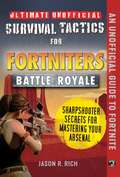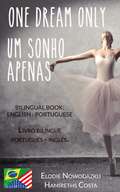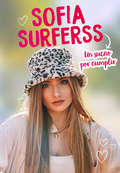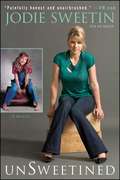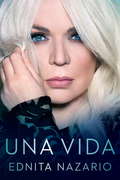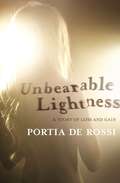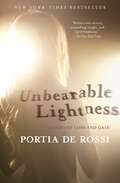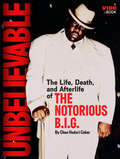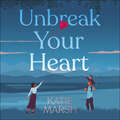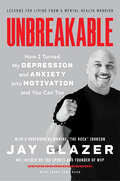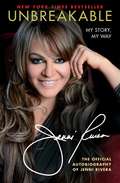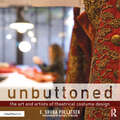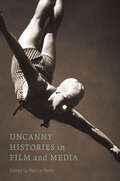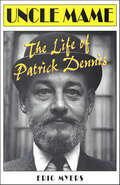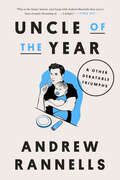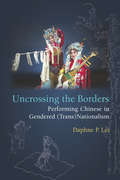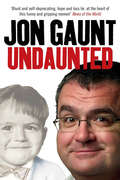- Table View
- List View
Ultimate Unofficial Survival Tactics for Fortnite Battle Royale: Discover the Island's Best Loot (Ultimate Survival Tactics for Fortnite B)
by Jason R. RichBe first to find the best loot and battle your way to victory! Ultimate Unofficial Survival Tactics for Fortnite Battle Royale: Discover the Island’s Best Loot offers a comprehensive overview of the game, and includes strategies for survival, building, exploration, and engaging in combat that every gamer must master to ultimately achieve success. Inside, you’ll discover what’s available and how to find and acquire the many different types of weapons, ammo, loot items, and resources, and learn proven strategies for using each item in a variety of situations that’ll aid in your survival and battle victories. Whether you’re using a PC, Mac, Playstation 4, Xbox One, Nintendo Switch, Apple iPhone, Apple iPad, or Android-based mobile device, this unofficial, full-color strategy guide will introduce you to the many different items that can be found, collected, and utilized during your stay on the island. Learn to assess situations and collect the best arsenal to meet your challengesFind your key to survival by knowing when and how to use your arsenalMaster strategies for survival, building, and explorationLearn the best way to engage in combat, which every gamer must master to achieve success
Ultimate Unofficial Survival Tactics for Fortnite Battle Royale: Mastering Game Settings for Victory (Ultimate Survival Tactics for Fortnite B)
by Jason R. RichThe Essential Guide to Maximizing Your Settings in Fortnite Battle Royale! Unlock a plethora of gaming tips and strategies to achieve victory! Ultimate Unofficial Survival Tactics for Fortnite Battle Royale: Mastering Game Settings for Victory explains to readers what each customizable setting within the game is used for and helps gamers fine-tune these settings to meet their unique needs. This full-color, unofficial guide will focus on customizing the game’s options and settings when playing on a PC or Mac, console-based gaming system, and/or on a mobile device. Using easy-to-understand explanations, along with hundreds of full-color screenshots, Ultimate Unofficial Survival Tactices for Fortnite Battle Royale: Mastering Game Settings for Victory will quickly become an indispensable resource for gamers looking to enhance and fully personalize their gaming experience. Learn the best uses for the 100+ user-customizable options in the gameFine-tune the game’s settings to enhance your gaming style, experience, and strengths as a playerImprove your performance by mastering the settings that fit your game-play
Ultimate Unofficial Survival Tactics for Fortnite Battle Royale: Sharpshooter Secrets For Mastering Your Arsenal (Ultimate Unofficial Survival Tactics for)
by Jason R. RichThe Ultimate Guide to Fortnite Weapon Use Strategy Power up your arsenal with Ultimate Unofficial Survival Tactics for Fortnite Battle Royale: Sharpshooter Secrets for Mastering Your Arsenal! This full-color, comprehensive guide unlocks the weapons and items offered within the game and shows you how to best use them. Inside, you’ll find in-depth strategies and techniques for achieving accurate aim, how to accomplish headshots, and how to make the best use of explosive and projectile weapons. Whether you’re on a PC, Mac, Playstation 4, Xbox One, Nintendo Switch, Apple iPhone, Apple iPad, or Android-based gaming system, you’ll learn how to utilize more than one hundred different types of weapons in order to achieve #1 Victory Royale. Learn the secrets to each weapon’s ammo type, capabilities, strengths, and weaknesses in order to use it effectively in a firefight. Additionally, you will develop a thorough understanding of the weapons, ammo types, and items available, and you will learn proven strategies for putting together the perfect personal arsenal for each phase of a match—including the End Game. • Master close-range, mid-range, and long-range combat techniques • Learn how to use weapons and items to build your skills and win battles and firefights • Know how, when, and where to find weapons and ammo • Find out how utilize loot items that serve as weapons, including Grenades, Clingers, Remote Explosive, Stink Bombs, etc. • Learn how to strategize your survival by utilizing health and shield powerups
Um Sonho Apenas/One Dream Only (Livro bilíngue: Português - Inglês)
by Elodie Nowodazkij Hamíreths CostaEstá aprendendo inglês? Are you learning Portuguese? This book can help you with that: one page in English, one page in Portuguese... Este livro pode te ajudar: uma página em inglês e outra em português... She thought she was on her way to the top... Sixteen-year-old Natalya Pushkaya has one dream and one dream only: becoming the best ballerina ever.Dancing's always been who she is and she's working her hardest to land the main role of the School of Performing Arts' end-of-the-year showcase. But...will she make it? Within a week, Natalya's life will be changed forever. ------------------------------------- Ela achava que estava a caminho do topo... Natalya Pushkaya de 17 anos tem um sonho apenas: se tornar a melhor bailarina do mundo. Dançar sempre foi o que ela é e ela está trabalhando duro para conseguir o papel principal no show de final de ano da Escola de Artes Cênicas. Mas ela vai conseguir? Em uma semana a vida de Natalya vai mudar para sempre.
Un sueño por cumplir
by Sofía Surferss¡Una nueva aventura de Sofía Surferss! La carrera de Sofía Surferss no para de crecer. Tiene un montón de proyectos chulísimos, como grabar un anuncio superguay en Madrid. Además, su madre y su hermana también se vienen. ¡Viaje de chicas! Sin embargo, entre las muchas aventuras que les esperan en la gran ciudad, se esconde algún que otro contratiempo... ¡¿pero por qué tiene tanta mala suerte?! ¿Conseguirá Sofía salir airosa de todos sus accidentes y llegar a tiempo al rodaje? No te pierdas una nueva aventura de Sofía Surferss
UnSweetined: A Memoir
by Jodie Sweetin Jon WarechBeloved Full House star Jodie Sweetin recounts her journey from being one of America's sweethearts to a life of drug abuse and finally recovery.
Una Vida
by Ednita Nazario“Ednita siempre ha sido la “gran dama” que nos señaló el camino, con un espíritu de innovación, tenacidad y entendiendo lo que es la música actual”. —Ricky Martin Pocos cantantes han sido capaces de generar el interés internacional y multigeneracional del que ha disfrutado la artista Ednita Nazario. Una de las estrellas del pop latino más admiradas y con más grabaciones que han resultado en hits, es reconocida por su riqueza vocal y su magnética presencia en los escenarios. En estas páginas Ednita, la diva más amada de Puerto Rico, por primera vez abre su corazón narrando su vida entera, con detalles nunca antes revelados al público. Desde sus humildes comienzos en Ponce, pasando por la pérdida de su gran amor, la bancarrota emocional y financiera y finalmente el regreso al estrellato. Ednita nos abre su corazón y su historia con absoluta sinceridad y transparencia, desde los momentos más felices de su vida hasta los más desgarradores. Una historia de inspiración, amor, familia: esta es Ednita Nazario con toda la pasión y el talento que la han convertido en una de las estrellas más celebradas de nuestra era.
Unauthorized America: A Travel Guide to the Places the Chamber of Commerce Won't Tell You About
by Vince Staten"The travel brochures never mention JFK's Love Nest, where he and Marilyn Monroe would meet for an after-noon tryst, or Elvis's Drugstore, where the King loaded up on downers. But let's face it: not everyone wants to spend summer vacation watching Junior slither down the water slide or trailing Grandpa as he treks from one historic marker to the next. Not everyone wants a Disney World vacation. This book boldly dares to take you where no travel brochures have taken you before, to the out-of-the-way sights and the offbeat vacation spots nobody touts. This is an underground guide to America, to the places that you Really want to see: where John Lennon was shot, where Margaret Mitchell was run over by a car, where Sean Penn punched out a photographer, where Fawn Hall shredded boss Ollie North's papers. These are the places the local Chamber of Commerce won't tell you about. But we will."
Unbearable Lightness: A Story of Loss and Gain
by Portia De RossiI didn't decide to become anorexic. It snuck up on me disguised as a healthy diet, a professional attitude. Being as thin as possible was a way to make the job of being an actress easier . . . Portia de Rossi weighed only 82 pounds when she collapsed on the set of the Hollywood film in which she was playing her first leading role. This should have been the culmination of all her years of hard work first as a child model in Australia, then as a cast member of one of the hottest shows on American television. On the outside she was thin and blond, glamorous and successful. On the inside, she was literally dying. In this searing, unflinchingly honest book, Portia de Rossi captures the complex emotional truth of what it is like when food, weight, and body image take priority over every other human impulse or action. She recounts the elaborate rituals around eating that came to dominate hours of every day, from keeping her daily calorie intake below 300 to eating precisely measured amounts of food out of specific bowls and only with certain utensils. When this wasn't enough, she resorted to purging and compulsive physical exercise, driving her body and spirit to the breaking point. Even as she rose to fame as a cast member of the hit television shows Ally McBeal and Arrested Development, Portia alternately starved herself and binged, all the while terrified that the truth of her sexuality would be exposed in the tabloids. She reveals the heartache and fear that accompany a life lived in the closet, a sense of isolation that was only magnified by her unrelenting desire to be ever thinner. With the storytelling skills of a great novelist and the eye for detail of a poet, Portia makes transparent as never before the behaviors and emotions of someone living with an eating disorder. From her lowest point, Portia began the painful climb back to a life of health and honesty, falling in love with and eventually marrying Ellen DeGeneres, and emerging as an outspoken and articulate advocate for gay rights and women's health issues. In this remarkable and beautifully written work, Portia shines a bright light on a dark subject. A crucial book for all those who might sometimes feel at war with themselves or their bodies, Unbearable Lightness is a story that inspires hope and nourishes the spirit.
Unbearable Lightness: A Story of Loss and Gain
by Portia De Rossi"I didn't decide to become anorexic. It snuck up on me disguised as a healthy diet, a professional attitude. Being as thin as possible was a way to make the job of being an actress easier . . ." Portia de Rossi weighed only 82 pounds when she collapsed on the set of the Hollywood film in which she was playing her first leading role. This should have been the culmination of all her years of hard work--first as a child model in Australia, then as a cast member of one of the hottest shows on American television. On the outside she was thin and blond, glamorous and successful. On the inside, she was literally dying. In this searing, unflinchingly honest book, Portia de Rossi captures the complex emotional truth of what it is like when food, weight, and body image take priority over every other human impulse or action. She recounts the elaborate rituals around eating that came to dominate hours of every day, from keeping her daily calorie intake below 300 to eating precisely measured amounts of food out of specific bowls and only with certain utensils. When this wasn't enough, she resorted to purging and compulsive physical exercise, driving her body and spirit to the breaking point. Even as she rose to fame as a cast member of the hit television shows Ally McBeal and Arrested Development, Portia alternately starved herself and binged, all the while terrified that the truth of her sexuality would be exposed in the tabloids. She reveals the heartache and fear that accompany a life lived in the closet, a sense of isolation that was only magnified by her unrelenting desire to be ever thinner. With the storytelling skills of a great novelist and the eye for detail of a poet, Portia makes transparent as never before the behaviors and emotions of someone living with an eating disorder. From her lowest point, Portia began the painful climb back to a life of health and honesty, falling in love with and eventually marrying Ellen DeGeneres, and emerging as an outspoken and articulate advocate for gay rights and women's health issues. In this remarkable and beautifully written work, Portia shines a bright light on a dark subject. A crucial book for all those who might sometimes feel at war with themselves or their bodies, Unbearable Lightness is a story that inspires hope and nourishes the spirit.
Unbelievable
by Cheo Hodari CokerIn this riveting account of Biggie's remarkable life, hip hop journalist Cheo Hodari Coker tells the story you've never heard about the dramatic, tension-filled world of Biggie, Tupac, Puff Daddy, and Suge Knight, tracing their friendships and feuds from the beginning to the bitter end. Despite the clash of personalities and styles, all four were key players in a volatile and creative era of hip hop, a time when gangsta rap became popular music.Before he rocketed to fame as Biggie, Christopher Wallace was a young black man growing up in Brooklyn with a loving single mother. An honors student who dropped out of school to sell drugs, Biggie soon discovered that he had a gift for rocking the mike. Coker's narrative is based on exclusive interviews with Biggie's family and friends, some of whom have never spoken publicly about Biggie before.Compellingly written and brilliantly illustrated, with rare color and black-and-white photographs from VIBE's archives and Biggie's family, this is an in-depth look at the life and afterlife of an icon whose music is as powerful and prevalent as ever. A virtuoso of flow as well as a master storyteller, Biggie was arguably the greatest rapper of all time. We've heard a lot of speculation about Biggie's death. Now it's time to remember his life and celebrate his work.
Unbreak My Heart: A Memoir
by Toni BraxtonThe bestselling solo R&B artist finally opens up about her rocky past and her path to redemptionWhile Toni Braxton may appear to be living a charmed life, hers is in fact a tumultuous story: a tale of personal triumph after a public unraveling. In her heartfelt memoir, the six-time Grammy Award-winning singer and star of WE tv's hit reality series Braxton Family Values is unapologetically honest in revealing the intimate details of her journey.Toni and the entire Braxton clan have become America's favorite musical family, but what fans may not know is the intense guilt Toni once felt when she accepted a recording deal that excluded her sisters. That decision would haunt Toni for years to come, tainting the enormous fame she experienced as a popular female vocalist at the top of the charts. Despite her early accomplishments, Toni's world crumbled when she was forced to file for bankruptcy twice and was left all alone to pick up the pieces.Always the consummate professional, Toni rebuilt her life but then found herself in the midst of more heartache. The mother of an autistic child, Toni had long feared that her son's condition might be karmic retribution for some of the life choices that left her filled with remorse. Later, when heart ailments began plaguing her at the age of forty-one and she was diagnosed with lupus, Toni knew she had to move beyond the self-recrimination and take charge of her own healing—physically and spiritually.Unbreak My Heart is more than the story of Toni's difficult past and glittering success: it is a story of hope, of healing, and, ultimately, of redemption.
Unbreak Your Heart: An emotional and uplifting love story that will capture readers' hearts
by Katie MarshThree broken hearts. One extraordinary love story.Seven-year-old Jake's heart is failing and he doesn't want to leave his dad, Simon, alone. So he makes a decision: to find Simon someone to love before he goes.Beth is determined to forget the past. But even when she leaves New York to start afresh in a Lake District village, she can't shake the secrets that haunt her.Single dad Simon still holds a candle for the woman who left him years ago. Every day is a struggle to earn a living while caring for his beloved son. He has no time for finding someone new.But Jake is determined his plan will succeed - and what unfolds will change all three of them forever.(P) 2021 Hodder & Stoughton Ltd
Unbreakable: How I Turned My Depression and Anxiety into Motivation and You Can Too
by Jay GlazerJay Glazer—a top NFL insider on Fox NFL Sunday, an MMA coach, actor, and a veteran advocate and founder of MVP (Merging Vets and Players)—offers honest, in your face advice and insights gleaned from his fight through depression and anxiety, his successful careers in NFL journalism and business, as well as his work with military vets struggling with PTSD; the result is a relentless, unapologetic, and no-nonsense approach to overcoming your self-doubts, fears, and excuses… with the goal of becoming Unbreakable.In Unbreakable, Jay Glazer talks directly to you, his teammates, and shares his truth. All the success from his screeching-and-swerving joy ride through professional football, the media, the MMA fighting world, Hollywood, the military-warrior community, comes with a side of relentless depression and anxiety. Living in the gray, as Jay calls it, is just a constant for him. And, in order to work through and work better, Jay knows he has to keep going, to be of service, to believe in himself when no one else will, and be stronger, tougher, and more dedicated than anyone. Unbreakable is his story of how he has done this in all of his many endeavors—a relentless insider who won’t quit talking or take his foot off the gas, whether detailing how he got his big break inside the NFL (it involves a friendship with Michael Strahan that seems too unlikely even for Hollywood) or helping veterans fight for their lives in gyms around the country or playing himself on the hit show Ballers, Jay’s ability to laugh at himself and take on his mental struggles has given him a clarity, toughness, and openness that few people can rival.Throughout Unbreakable, Jay will use his stories—featuring some of the biggest, baddest, and most fascinating characters in the public eye today—to tackle the toughest subjects by making you laugh. He will also use them as motivation to outline a prescriptive plan for you to get to the top of your game, whatever your game is, and to stop making excuses. He will show you how to use your insecurities, your own battles with mental health, to get where you need to go, scars and all. Especially scars and all.
Unbreakable: My Story, My Way
by Jenni RiveraThe story behind Telemundo&’s Jenni Rivera: Mariposa del Barrio series, now streaming. A New York Times bestseller, this is the official biography from the beloved Mexican-American singer who lost her life in a tragic plane crash.The only autobiography authorized by Jenni Rivera "I can’t get caught up in the negative because that destroys you. Perhaps trying to move away from my problems and focus on the positive is the best I can do. I am a woman like any other, and ugly things happen to me like any other woman. The number of times I have fallen down is the number of times I have gotten up." These are the last words that beloved Mexican American singer Jenni Rivera spoke publicly before boarding the plane that would crash and cut her life short on December 9, 2012. However, they are not the final words that La Diva de la Banda had for the world. Those are found in the pages you hold in your hands, Jenni’s own account of the highs and lows of her extraordinary journey. She became the most acclaimed Spanish-language singer in the United States and sold more than 15 million records worldwide. A single mother of five and grandmother of two, she was also an actress, a television producer, the star of her own reality show, and an entrepreneur. But for all its immense success, Jenni’s life often seemed to be a series of personal battles in which perseverance was her only weapon. As her fame grew, she made it her mission to speak about her struggles, forging an intimate connection with her fans. She became a figure of strength and a source of encouragement to women of all ages. In Unbreakable, Jenni recounts the crucial moments in her past, revealing her experiences with domestic and sexual abuse, divorce, body image issues, making her way in a male-dominated industry, raising her children as a single mother, and learning that she could depend only on herself. Though she is no longer with us, Jenni will always be the "Rivera rebel from Long Beach," the girl who maintained her sense of humor and fighting spirit in every circumstance. In this remarkable memoir, Jenni leaves behind a legacy of inspiration and determination that will forever live on through her precious family, friends, and fans.
Unbuttoned: The Art and Artists of Theatrical Costume Design
by Shura PollatsekUnbuttoned: The Art and Artists of Theatrical Costume Design documents the creative journey of costume creation from concept to performance. Each chapter provides an overview of the process, including designing and shopping; draping, cutting, dyeing, and painting; and beading, sewing, and creating embellishments and accessories. This book features interviews with practitioners from Broadway and regional theatres to opera and ballet companies, offering valuable insights into the costume design profession. Exceptional behind-the-scenes photography illustrates top costume designers and craftspeople at work, along with gorgeous costumes in progress.
Unbuttoned: The Art and Artists of Theatrical Costume Design
by Shura PollatsekUnbuttoned: The Art and Artists of Theatrical Costume Design documents the creative journey of costume creation from concept to performance. Each chapter provides an overview of the process, including designing and shopping; draping, cutting, dyeing, and painting; and beading, sewing, and creating embellishments and accessories. This book features interviews with practitioners from Broadway and regional theatres to opera and ballet companies, offering valuable insights into the costume design profession. Exceptional behind-the-scenes photography illustrates top costume designers and craftspeople at work, along with gorgeous costumes in progress.
Uncanny Histories in Film and Media (Media Matters)
by Priya Jaikumar Masha Salazkina Peter Bloom Ellen C. Scott Cristina Venegas Jasmine Nadua Trice Alenda Chang Maria Corrigan Naomi DeCelles Hannah GoodwinUncanny Histories in Film and Media brings together a stellar lineup of established and emergent scholars who explore the uncanny twists and turns that are often occluded in larger accounts of film and media. Prompted by fresh archival research and new conceptual approaches, the works included here probe the uncanny as a mode of historical analysis that reveals surprising connections and unsettling continuities. The uncanny stands for what often eludes us, for what remains unfamiliar or mysterious or strange. Whether writing about film movements, individual works, or the legacies of major or forgotten critics and theorists, the contributors remind us that at the heart of the uncanny, and indeed the writing of history, is a troubling of definitions, a challenge to our inherited narratives, and a disturbance of what was once familiar in the uncanny histories of our field.
Uncle John's Bathroom Reader Tunes into TV
by Bathroom Readers' InstituteWhat does Homer Simpson call "friend...mother...secret lover?" Television, you meathead! Here comes your wacky neighbor Uncle John to present TV the way only he can. From test patterns to Top Chef, from My Three Sons to Mad Men, as well as TV news, advertising, scandals, sitcoms, dramas, reality shows, and yadda yadda yadda, Uncle John's Bathroom Reader Tunes into TV is "dy-no-mite!" Read about...Gilligan's seven deadly sinsThe inside story of TV's first commercialWhat goes on behind the scenes of Jeopardy!The most incredibly bizarre shows from around the worldWhy Gene Roddenberry tried to beam the original Star Trek cast into spaceWhat reality show producers don't want you to knowHow the King of Late Night crushed his competitionWhat really went down on the island of LOSTUnexpected sitcom fatalitiesTV's greatest chimpsAnd much, much more!
Uncle Mame: The Life of Patrick Dennis
by Eric MyersEdward Everett Tanner III, under his pseudonyms of Patrick Dennis and Virginia Rowans, was the author of sixteen novels - most of them bestsellers - including the classics Little Me and Genius. But, despite the success of his other works, he is by best known and best remembered for his most indelible creation - Auntie Mame. Born and raised in the affluent suburbs of Chicago, Tanner moved to New York City after World War II and embarked upon a writing career. His first two books were published with a whimper - attracting few reviews and fewer sales - and his third book was rejected by nineteen publishers before being accepted at a relatively small house. But Auntie Mame became a phenomena spending two years on the bestseller lists, adapting into a successful play, movie, and later a musical. As a result of this and later successes, Tanner made millions and became the toast of a certain bohemian segment of Manhattan arts society. He also spent every cent he ever made. Torn between his wife and family and his own awakening realization of his homosexuality, he separated from his wife and moved to Mexico. By the early 70's, his writing career over, he embarked upon a new career - as a butler to some of the wealthiest families in America.Based on extensive interviews with co-workers, friends, and relatives, Uncle Mame is a revealing, appealing portrait of a great American character. Easily the counterpart of such revered wits as P. G. Wodehouse and Evelyn Waugh, Dennis is not only the man who brought camp to the American mainstream but he also lived a life as wild, poignant, madcap, and intriguing as any of his own books.
Uncle Tom's Cabins: The Transnational History of America's Most Mutable Book
by Tracy C Davis Stefka MihaylovaAs Harriet Beecher Stowe’s novel Uncle Tom’s Cabin traveled around the world, it was molded by the imaginations and needs of international audiences. For over 150 years it has been coopted for a dazzling array of causes far from what its author envisioned. This book tells thirteen variants of Uncle Tom’s journey, explicating the novel’s significance for Canadian abolitionists and the Liberian political elite that constituted the runaway characters’ landing points; nineteenth-century French theatergoers; liberal Cuban, Romanian, and Spanish intellectuals and social reformers; Dutch colonizers and Filipino nationalists in Southeast Asia; Eastern European Cold War communists; Muslim readers and spectators in the Middle East; Brazilian television audiences; and twentieth-century German holidaymakers. Throughout these encounters, Stowe’s story of American slavery serves as a paradigm for understanding oppression, selectively and strategically refracting the African American slave onto other iconic victims and freedom fighters. The book brings together performance historians, literary critics, and media theorists to demonstrate how the myriad cultural and political effects of Stowe’s enduring story has transformed it into a global metanarrative with national, regional, and local specificity.
Uncle of the Year: & Other Debatable Triumphs
by Andrew RannellsFrom the star of The Book of Mormon and Girls, candid, hilarious essays on anxiety, ambition, and the uncertain path to adulthood that ask: How will we know when we get there? &“With the unsparing eye of David Sedaris and the social wisdom of Nora Ephron, Andrew Rannells tackles the most foundational questions of growing up.&”—Lena DunhamIn Uncle of the Year, Andrew Rannells wonders: If he, now in his forties, has everything he&’s supposed to need to be an adult—a career, property, a well-tailored suit—why does he still feel like an anxious twenty-year-old climbing his way toward solid ground? Is it because he hasn&’t won a Tony, or found a husband, or had a child? And what if he doesn&’t want those things? (A husband and a child, that is. He wants a Tony.) In deeply personal essays drawn from his life as well as his career on Broadway and in Hollywood, Rannells argues that we all pretend—for friends, partners, parents, and others—that we are constantly succeeding in the process known as &“adulting.&” But if this acting is leaving us unfulfilled, then we need new markers of time, new milestones, new expectations of what adulthood is and can be. Along the way, Rannells navigates dating, aging, mental health, bad jobs, and much more. In his essay &“Uncle of the Year,&” he explores the role that children play in his life, as a man who never thought having kids was necessary or even possible—until his siblings have kids and he falls in love with a man with two of his own. In &“Always Sit Next to Mark Ruffalo,&” he reveals the thrills and absurdities of the awards circuit, and the desire to be recognized for one&’s work. And in &“Horses, Not Zebras,&” he shares the piece of wisdom that helped him finally come to terms with his anxiety and perfectionism. Filled with honest insights and a sharp wit, Uncle of the Year challenges us to take a long look at who we&’re pretending to be, who we know we are, and who we want to become.
Unconquered: The Saga of Cousins Jerry Lee Lewis, Jimmy Swaggart, and Mickey Gilley (Unconquered Ser.)
by J.D. Davis&“Engaging . . . [a] biography of three men bound by blood, music, and a lifelong struggle to strike a balance between the sacred and secular.&”—Publishers WeeklyThree cousins, inseparably bonded through music. Each became a star; their story would become a legend. J. D. Davis&’s enthralling new biography of famous cousins Jerry Lee Lewis, Jimmy Swaggart, and Mickey Gilley, born within a twelve-month span in small-town Louisiana during the Great Depression, draws from exhaustive research and personal connections with friends and family. Davis recreates the irresistible and life-changing power of music that surrounded the cousins as boys and shaped their engagingly distinct paths to fame. With three personal journeys set alongside important landmarks in pop-culture history, Davis presents a unique tale of American music centered on the trials, tribulations, and achievements of three men who remain truly Unconquered.A ForeWord Reviews Book of the Year Award Honorable Mention for Biography&“This is a good read, and not just for the hard-core fan. It will appeal to anyone interested in the dynamics of rock &’n&’ roll, country music, and evangelical Christianity and what happens when the aesthetics and lifestyles of those three worlds collide. Highly recommended.&”—Library Journal&“God, the devil, and everything in between. This book is a great representation of the duality plane on which we exist.'&”—Leon Russell, legendary musician, Rock and Roll Hall of Fame member &“Unconquered clearly depicts the fascinating story of three great musical artists who were cousins in real life but icons in the world of music. Each man conquered life&’s roadblocks to achieve his ultimate goals.&”—Tom Schedler, former Louisiana Secretary of State
Uncrossing the Borders: Performing Chinese in Gendered (Trans)Nationalism
by Daphne LeiOver many centuries, women on the Chinese stage committed suicide in beautiful and pathetic ways just before crossing the border for an interracial marriage. Uncrossing the Borders asks why this theatrical trope has remained so powerful and attractive. The book analyzes how national, cultural, and ethnic borders are inevitably gendered and incite violence against women in the name of the nation. The book surveys two millennia of historical, literary, dramatic texts, and sociopolitical references to reveal that this type of drama was especially popular when China was under foreign rule, such as in the Yuan (Mongol) and Qing (Manchu) dynasties, and when Chinese male literati felt desperate about their economic and political future, due to the dysfunctional imperial examination system. Daphne P. Lei covers border-crossing Chinese drama in major theatrical genres such as zaju and chuanqi, regional drama such as jingju (Beijing opera) and yueju (Cantonese opera), and modernized operatic and musical forms of such stories today.
Undaunted: The True Story Behind the Popular Shock-Jock
by Jon GauntMillions know him as a loudmouth radio shock-jock and Sun columnist. Yet, in his life Jon Gaunt has had to overcome unimaginable hardship, solitude, bankruptcy and despair. His mother died suddenly when he was just twelve, his hard-drinking, womanising father abandoned him to suffer appalling treatment in a children's home. At twenty-eight, his business had a million pound turnover, but a stroke of fate caused catastrophe. Undaunted, Jon Gaunt has always fought back. Behind the outspoken media personality, this is the very human story of self-preservation, personal growth and forgiveness, told in Jon's inimitable forthright style.


